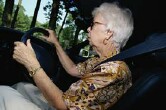
THURSDAY, March 10 (HealthDay News) — One reason that elderly people tend to be slower drivers than younger people is because they have a narrower field of vision and have more difficulty seeing pedestrians, according to a new study.
Israeli researchers tested experienced elderly and non-elderly drivers, and compared the differences between them in reaction times and when pedestrians were perceived as hazards.
Driving simulator tests showed that the elderly drivers noticed pedestrians half as often as younger drivers and also took longer to respond to hazardous situations involving pedestrians.
The elderly drivers reduced their driving speed by almost 20 percent in order to give themselves more time to respond to hazards and dangers, said the team at Ben-Gurion University of the Negev.
The study was released online in advance of publication in an upcoming print issue of the journal Accident Analysis and Prevention.
“These findings strengthen the notion that elderly drivers, shown to have a narrower useful field of view, may also be limited in their ability to detect hazards, particularly when outside the center of their view,” Tal Oron-Gilad, of the department of industrial engineering, said in a university news release.
She added that “authorities should be aware of these limitations and increase elderly drivers’ awareness of pedestrians by posting traffic signs or dedicated lane marks that inform them of potential upcoming hazards.”
More information
The U.S. Centers for Disease Control and Prevention has more about older adult drivers.

